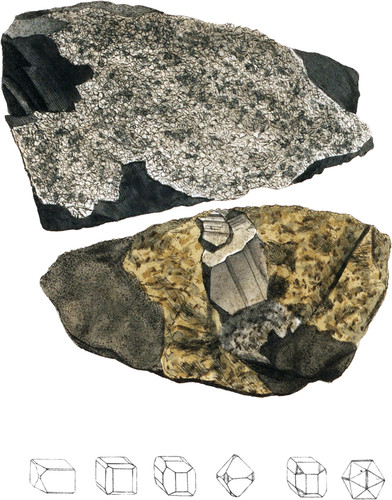 Enlarge
Enlarge
Exotic Mineralogy
Grey Cobalt Ore
- Syn.
- Cobalt gris, Haüy, Tabl. 107, Traité 4. 204.
- Mine de Cobalt arsenico-sulfureuse, De Lisle, 3. 129.
- Cobalt blanc, De Born, 2. 180.
- Glanz Kobolt, Emmerl. 2. 488.
- Cobalt arsenical, Daubenton, Tabl. 33.
- Bright white Cobalt-Ore, Kirw. 2. 273.
- White Cobalt-Ore, Jameson, 2. 432.
Found chiefly at Tunaberg in Sweden, especially the finer crystallized specimens; also in Norway, and at Giern in Silicia, in beds which, according to Jameson, lie in Mica slate. The present specimens were both lent me by Dr. Babington; the upper one was from Hesse, the other from Tunaberg. The upper specimen is crystallized in small irregular cubo-octaëdrons, chiefly on the surface of part of a dark Schistose rock, their surfaces are smooth, and their lustre much more splendid than imitable.
The lower specimen is a larger crystal than is usual, in a matrix of Copper Pyrites, with Carbonate of Lime and Coccolite; it is a cube modified by the faces of the pentagonal dodecaëdron, shown in the slate of Sulphuret of Iron, Tab. 22, Brit. Min. These substances commonly assuming the same figure, the forms of the crystals of either will designate the other.
Having a number of crystals presented to me by the generous Mr. Swedenstierna when in England, which happen to be such as elucidate the subject in a proper manner, I avail myself of them. They were brought, with other varieties, as to purity, value, &c. among samples for sale, and are detached more or less perfect crystals. They are cubes and octaëdrons, the cubes variously elongated and modified, either with the solid angles truncated, approaching the octaëdron, or with the edges alternately bevilled, in the manner of the large figure, with the faces of the pentagonal dodecaëdron. The first geometrical figure on the left hand shows a lengthened parallelogram with two comers truncated, and the edges slightly bevilled; the little square facet is one of these bevilled edges. The next outline has the edges more largely bevilled, and the third deeper still; the faces between being those of the cube, they are quite complete in the figure of Sulphuret of Iron above alluded to. The next figure is the regular octaëdron with small remains of the faces of the cube, often six-sided, and the two triangular faces on either side alternating on the points of the octaëdron correspond with the faces of the dodecaëdron above-mentioned. The next differs from the first chiefly in having bevillings at some of the corners around the triangular faces, and is a rare modification. The right hand figure is the Icosaëdron complete, having twenty equilateral triangular faces, those of the octaëdron and pentagonal dodecaëdron meeting regularly; where three lines are drawn there are sometimes the remains of the faces of the cube. Thus this figure has the faces of the octaëdron, dodecaëdron, and signs of those of the cube combined.
Cobalt is so like Iron Pyrites, that it is not easily distinguished; however, an eye accustomed to discriminate Mineral substances, will soon recognize it. It has however some characters which may help the novice by description. It has a whiter splendour, with something of a crimson tarnish, Pyrites is more likely to be rusty, it is softer or more easily frangible than Iron Pyrites. Lustre highly metallic; fracture more or less fine grained, rather foliated in the direction of the faces of the cube. A blow, or heat, will cause a strong garlick-like odour, which, however, is also the case with Arsenical Pyrites. Cobalt has the peculiar property of colouring the glass of Borax of a fine ultramarine blue. Melts before the blow-pipe easily, giving out a thick white smoke.
| By Klaproth. | By Tassaert. | |
|---|---|---|
| Cobalt | 44.0 | 36.66 |
| Arsenic | 55.5 | 49.00 |
| Sulphur | 0.5 | 5.66 |
| Iron | 0.0 | 5.66 |
| Loss | 0.0 | 2.18 |
| 100.0 | 100.00 | |

